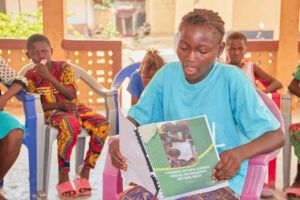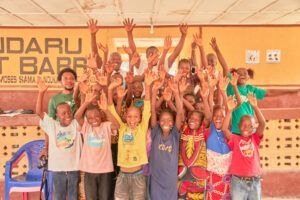 Stories
Stories
December 28, 2023 • 4 min read
Sierra Leone has one of the highest adolescent pregnancy rates in the world. 28% of adolescent girls between the ages of 15 and 19 in Sierra Leone have begun childbearing, and 22% of these adolescents have already given birth.
High rates of adolescent pregnancy
Children born to adolescent mothers are at an increased risk of illness, death, and other adverse pregnancy outcomes. Worryingly, pregnancy-related deaths are the leading cause of mortality for young women. 46.8% of adolescent deaths in Sierra Leone occur due to pregnancy and childbirth complications.
Adolescent mothers are also unable to pursue educational opportunities that could improve the quality of their lives, their incomes, and their ability to care for their children. Rural adolescents are particularly vulnerable to adverse pregnancy outcomes. The lack of resources in rural Sierra Leone has resulted in an adolescent pregnancy rate of 34%, compared to 19% in urban areas.
To improve health outcomes for mothers and infants, GOAL is working to reduce adolescent pregnancy in Sierra Leone with a variety of adolescent sexual and reproductive health interventions.
Sexual violence and exploitation fuels, in part, the high adolescent pregnancy rate in Sierra Leone. Engrained social and gender norms leave young girls vulnerable. The United Nations ranked Sierra Leone 155 out of 162 countries for gender equality. An estimated 62% of women in Sierra Leone between the ages of 15 and 19 have experienced physical or sexual violence.
Engaging Communities
GOAL uses a Social and Behaviour Change Communication (SBCC) approach as part of our adolescent sexual and reproductive health (ASRH) interventions. GOAL teams use interactive community dialogues with key influencers to effect change in social norms around ASRH, which reduce the social inequality and vulnerability of girls, and eliminate the stigma related to contraceptive use.
For social and cultural reasons, young girls in Sierra Leone are actively discouraged from accessing sexual and reproductive health services and information. With girls as young as twelve becoming pregnant, GOAL is working with local communities to break through these barriers and provide accurate information to teenagers.
In rural Kenema, GOAL is actively working with communities to educate young people about the negative impacts of teenage pregnancy. Working with key influencers, an adult mentor guides adolescents through role plays, presentations, and Q&A sessions to help them internalise this knowledge.
Adolescents can also serve as a peer mentor, facilitating workshops on adolescent sexual and reproductive health with other young people in their community. These sensitisations equip young girls with the tools and knowledge they need to make informed decisions related to sexual and reproductive health.
Many of these peer mentors begin their involve with GOAL as ‘male champions,’ who facilitate sensitisation sessions with other young men in their community to effect social change. The aim is to cultivate an environment in which women and girls are protected, empowered, and treated with respect.
Delivering results
In the districts of Sierra Leone where GOAL implemented its ASRH programming, the percentage of female youth and adolescents aged 15 to 19 who used a modern method of contraception rose from 38% in 2018 to 58% in 2022. For women aged 20 to 24, the figure rose from 26% to 71%.
In all three target districts, this increase directly correlated with a reduction in the number of adolescents presenting for antenatal services and decreased adolescent deliveries. The percentage of adolescents and young people from 10 to 24 years old with basic knowledge about sexual and reproductive health and protection services also increased from 32% in 2019 to 70% in 2022.

Isata, a GOAL peer mentor, facilitating an interactive community dialogue on adolescent sexual and reproductive health.
Isata’s Story
Isata Kallon is a grade six pupil at Methodist Primary School in Sanadaru Village, Kenema District. The adolescent pregnancy rate in Sanadaru Village is very high, which prompted Isata to become a GOAL peer mentor. Isata facilitates community dialogue sessions in which she teaches adolescents in Sandaru about the risks of teenage pregnancy, the dangers of early marriage, and the benefits of contraception.
“I was trained by GOAL on adolescent sexual and reproductive health so I could act as a peer mentor in my school and community. My responsibility is to teach other young girls the effects of teenage pregnancy and encourage them to abstain from early sex. We used to have a high rate of cases of teenage pregnancy here in Sandaru, but since we started these dialogue sessions with other adolescents, we have experienced a significant decrease in the number of teenage pregnancy cases,” Isata said, smiling. “I want GOAL to begin helping other communities as well so that more adolescents will enrol in school. That is what I want.”
Fatou’s Story
Fatou, another adolescent living in Kenema, shared her experience of these sessions with Alison Cowzer, GOAL’s Vice Chairperson, on a recent visit.
“We regularly learn about reproductive health topics and how to avoid teenage pregnancy. We understand that it could hinder our dreams and goals,” Fatou explains. “Our GOAL mentor always asks us to close our eyes and envision our future. I consistently see myself as a future leader of my country, helping my fellow women citizens.”

Adolescents attending GOAL’s interactive community dialogue on adolescent sexual and reproductive health
